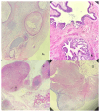Coexisting growing teratoma syndrome and gliomatosis peritonei following ovarian immature teratoma: a case report and literature review
- PMID: 39734342
- PMCID: PMC11673672
- DOI: 10.55730/1300-0144.5899
Coexisting growing teratoma syndrome and gliomatosis peritonei following ovarian immature teratoma: a case report and literature review
Abstract
Growing teratoma syndrome (GTS) is characterized by a reduction in serum tumor markers despite the growth of a benign mature teratomatous mass following chemotherapy for germ cell tumors. Gliomatosis peritonei (GP) typically accompanies ovarian teratomas, marked by the dissemination of mature glial tissue across the peritoneum. The concurrent presence of GTS and GP after treatment for ovarian immature teratoma (IMT) is notably rare, with approximately 20 reported cases. This case involves a 25-year-old patient who underwent surgical removal of an adnexal mass, which was later diagnosed as stage IIIA grade 3 ovarian IMT with parametrial involvement. Following two cycles of bleomycin, etoposide, and cisplatin chemotherapy, imaging identified new lesions adjacent to the liver and on the pelvic peritoneum. A second fertility-sparing surgery was performed, and paraffin pathology confirmed a mature teratoma within the excised specimen. Additionally, the resected pelvic peritoneum revealed nodules of mature glial tissue consistent with GP. The coexistence of GP with GTS post-IMT surgery presents a diagnostic challenge in distinguishing between malignant and benign components, which is critical to avoid unnecessarily aggressive surgical and chemotherapeutic treatments. Recognizing such cases may enable fertility-sparing surgery for these patients.
Keywords: Growing teratoma syndrome; gliomatosis peritonei; ovarian immature teratoma.
© TÜBİTAK.
Figures


References
-
- Bonazzi C, Peccatori F, Colombo N, Lucchini V, Cantù MG, et al. Pure ovarian immature teratoma, a unique and curable disease: 10 years’ experience of 32 prospectively treated patients. Obstetrics and Gynecology. 1994;84(4):598–604. - PubMed
-
- Małgorzata SŻ, Anna KG, Reszeć J, Krawczuk-Rybak M. Growing Teratoma Syndrome and Gliomatosis Peritonei in a 15-Year-Old Girl With Immature Ovarian Teratoma: Case Report and Review of the Literature. Journal of Pediatric and Adolescent Gynecology. 2021;34(6):885–889. doi: 10.1016/j.jpag.2021.07.009. - DOI - PubMed
Publication types
MeSH terms
Supplementary concepts
LinkOut - more resources
Full Text Sources
Medical

